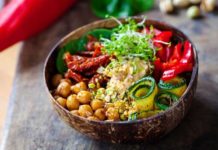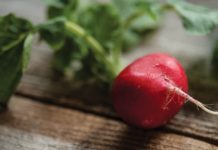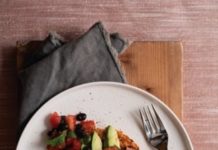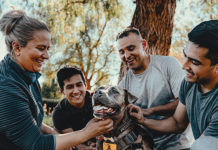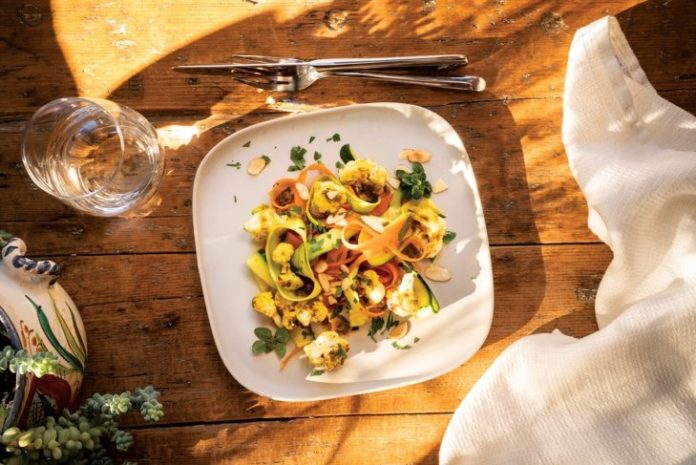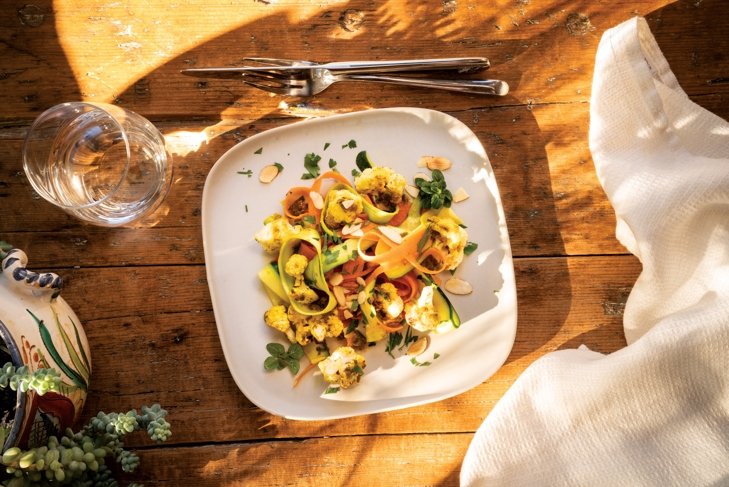
You’ve probably heard of IBS. But what is SIBO? Learn what researchers are discovering about this gastrointestinal disease, how to choose the best diet to treat its symptoms, and how to cook delicious meals that work around the restrictions.
Most of us encounter digestive issues from time to time. Who doesn’t remember occasionally experiencing post-meal regret following a memorable gorge session? The resolution, if you make one, might be to take it easy next time: maybe stop after the second helping. But for those who suffer with chronic digestive problems such as irritable bowel syndrome (IBS), following restrictive diets is often the only resolution.
IBS is a blanket diagnosis for gastrointestinal (GI) issues of the large intestine that affect up to 14 percent of adults and could be related to issues including changes in gut flora, gastroenteritis, the nervous system, inflammation, or muscle contractions in the intestines.
After consulting a gastroenterologist, IBS patients are often put on long-term restrictive diets that can eliminate gluten, lactose, or other food groups. But even then, they don’t always see improvement.
You may already know about IBS. But what is SIBO? Learn what researchers are discovering about this gastrointestinal disease, how to choose the best diet to treat its symptoms, and how to cook delicious meals that work around the restrictions.
What’s SIBO?
Another condition related to the GI system, but not as widely known, is small intestinal bacterial overgrowth (SIBO). This condition, found to affect a large percentage of those with IBS as well as others, involves the overgrowth of coliform bacteria in the small bowel and can cause a range of symptoms often mirroring those related to IBS.
This bacterial overgrowth can damage the intestinal lining, which allows undigested food particles to enter the bloodstream; this is also referred to by some as leaky gut syndrome. This can cause immune reactions, low iron, weight loss, and chronic fatigue.
SIBO symptoms include gas, diarrhea, abdominal pain, and bloating, just like IBS. The current most effective way of diagnosing SIBO is with a hydrogen and methane breath test; the colonic bacteria involved in SIBO produce these gases as a metabolic byproduct of fermenting carbohydrates.
Diet digest
With so many people affected by IBS, and as SIBO has begun to garner wider attention, a wave of new and old diets have emerged to help those afflicted to manage their symptoms. These diets often sport interesting acronyms:
- low-FODMAP: low-fermentable oligosaccharides, disaccharides, monosaccharides, and polyols (short-chain carbohydrates, or sugars, that aren’t absorbed properly in the gut by some people)
- SCD: specific carbohydrate diet
- AIP: autoimmune protocol
- GAPS: gut and psychology syndrome
The idea behind each of these diet protocols is to heal the gut lining and rebalance gut bacteria. Once symptoms abate, foods are slowly reintroduced. But knowing which diet will work for you can be difficult.
“Staying a long time in a low-FODMAP diet, you’ll be malnourished,” says Quebec naturopath Paola DeCicco. That diet shouldn’t last more than 14 weeks, while SCD and GAPS have more restrictive but shorter elimination phases followed by a year or more (if necessary) without nuts, grains, and soy, which can be particularly difficult for vegetarians who lose key protein sources.
Low-FODMAP diet
The low-fermentable oligosaccharides, disaccharides, monosaccharides, and polyols diet was created by researchers at Monash University in New Zealand who launched a smartphone app that allows you to create an individualized food guide.
In some cases, instead of eliminating foods such as mushrooms, peaches, and honey, small amounts are permitted according to your tolerance. For more information or to download the app, go to monashfodmap.com.
AIP diet
The AIP diet (autoimmune protocol) aims to decrease inflammation that leads to gut disorders and autoimmune disease. It’s a very restrictive diet that excludes a range of foods from grains, legumes, and dairy products to processed foods and sweeteners.
According to AIP nutritionist Jessica Flanigan, the diet goes beyond the paleo diet, to which it’s related, and can be used in conjunction with other diets, such as the low-FODMAP diet, or personalized if you have inflammatory reactions to particular foods.
SCD
Developed in the 1920s, the SCD (specific carbohydrate diet) is also similar to the paleo diet in that it restricts complex carbohydrates (dairy, grains, and most starches) and allows simple carbohydrates (fruit, honey, some vegetables, and yogurt).
These are theoretically easier to digest and absorb, leaving little excess for microbes to ferment. By starving these overgrown bacteria, the diet aims to return balance to your gut’s more than 400 bacterial species.
GAPS diet
A controversial diet, GAPS (gut and psychology syndrome) is a variation on the SCD that encourages eating yogurt and other unpasteurized dairy and fermented foods. The diet starts with an elimination phase based on meat broth (from meaty joints and bones rather than tendons) followed by an up to two-year maintenance phase, which incorporates meat broth and fermented vegetables at every meal.
A multi-front treatment
When it comes to SIBO, Kristy Regan, owner and nutritionist at Vital Foods Therapeutics, has some advice: “While a diet change might work for one-third of SIBO cases, most times people also need antibiotics and prokinetic after-treatment to remove the overgrowth.”
DeCicco agrees that you can’t ignore what else might be going on, like food moving too slowly through the digestive tract, low stomach acid, or a yeast overgrowth or parasite in the large intestine. “You’re not going to fix yourself by dealing just with SIBO,” she says.
In a study published by the World Journal of Gastroenterology, antibiotics and diet led to a 75 percent reduction in IBS symptoms, while a 2014 retrospective study found herbal remedies may be even more effective than rifaximin, the most prescribed antibiotic treatment for SIBO.
It’s a good idea to work with a professional who can address these other issues and interpret breath test results (SIBO Canada has a list of referring practitioners on its website, sibo.ca). Those results will determine which types of antibiotics (herbal or not) and probiotics could help.
It’s about balance, says DeCicco: “SIBO bacteria are normal bacteria, but you need to figure out how to bring the volume down from eight out of 10 to two out of 10.” There’s no perfect SIBO treatment, she adds.
“It’s important for people to try individual foods and see what works for them,” says Regan.
Comforting recipes for restricted diets
It’s important to still find pleasure in food, especially when so much is off-limits. A restrictive diet can be emotionally challenging for the strongest willed, so here are some comforting recipes that can be adapted to every diet. After all, life’s too short to not enjoy what you eat.
Recipes
Roasted Cauliflower Salad with Toasted Almonds and Ginger-Turmeric Vinaigrette (SCD & GAPS)

Thai Green Curry with Chicken or Chickpeas and Oyster Mushrooms (SCD)
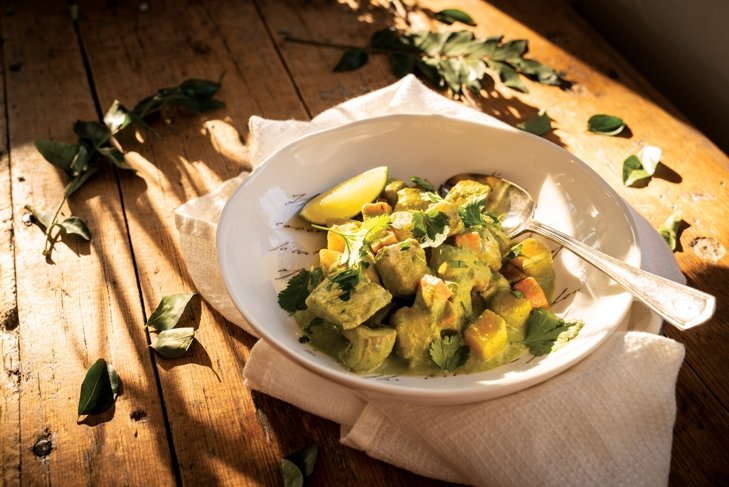
Indian Eggplant and Tomatoes with Fennel and Cumin (Low-FODMAP & SCD & GAPS)
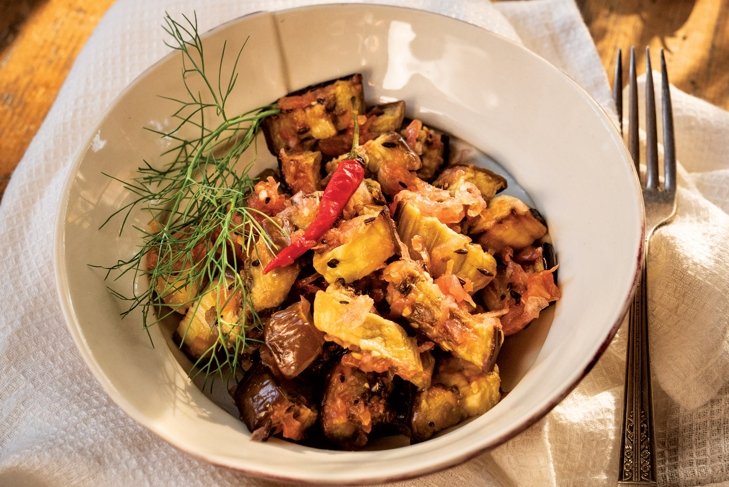
Cream Soda Parfait with Banana, Cantaloupe, and Vanilla Bean (Low-FODMAP & SCD & AIP & GAPS)

How to choose your diet
It’s important to work with a health care practitioner and qualified nutritionist to help choose the diet that best suits your particular nutritional needs.
All the available diets for those with IBS or SIBO (low-FODMAP, AIP, SCD, GAPS) are easier for omnivores, but Quebec naturopath Paola DeCicco says that simply removing disaccharides (chickpeas, sweet potatoes, grains, and most beans except lima beans, black beans, and lentils) might be enough.
This is a tweak on the SIBO Specific Diet by Dr. Allison Siebecker, co-founder and former medical director of the SIBO Center for Digestive Health at National University of Natural Medicine Clinic in Portland, Oregon. But for people who don’t find relief from other diets, Siebecker recommends a combination of low-FODMAPs and SCD, which reduces a broader range of fermentable carbohydrates.
Vegans and vegetarians
The low-FODMAP diet is the least restrictive for vegans. It allows quinoa, soy, most nuts, and small portions of some canned beans. It’s the only diet that allows rice, pea, or soy-based protein powders. But it’s the most restrictive of mushrooms (only oyster and enoki)—flavour-builders for vegetarian stocks and stews— and fruit, allowing only small portions of high-fructose fruits such as mangoes, figs, and cherries.
AIP disallows grains, legumes, nuts, nightshade vegetables (even chili flakes because they come from peppers), and seeds (including spices such as cumin, coriander, and nutmeg).
SCD allows some beans after IBS symptoms subside.
And while GAPS includes fermented foods such as cheese, kefir, and yogurt that are appropriate for non-vegan vegetarians, the diet revolves around meat broth.
IBS and SIBO in Canada
Canada has one of the highest rates of IBS in the world. The disease affects approximately 5 million Canadians, mostly women. According to the Canadian Digestive Health Foundation, it can develop after antibiotic use, new medications, surgery, food poisoning, or a change in diet or hormone levels.











